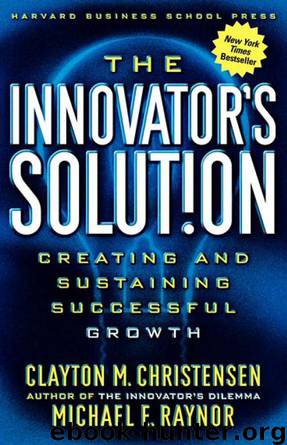The Innovator's Solution: Creating and Sustaining Successful Growth by Clayton M. Christensen; Michael E. Raynor

Author:Clayton M. Christensen; Michael E. Raynor
Language: eng
Format: mobi
Tags: Non-fiction, Forecasting, Industrial Management, Disruptive Technologies, Business, Success in Business, Customer Services, General, Management, Customer Service, Creative Ability in Business, Customer Relations, Business & Economics
ISBN: 9781578518524
Publisher: Harvard Business Press
Published: 2003-09-28T00:00:00+00:00
Being in the Right Place at the Right Time
We noted earlier that the pure forms of interdependence and modularity are the extremes on a continuum, and companies may choose strategies anywhere along the spectrum at any point in time. A company may not necessarily fail if it starts with a prematurely modular architecture when the basis of competition is functionality and reliability. It will simply suffer from an important competitive disadvantage until the basis of competition shifts and modularity becomes the predominant architectural form. This was the experience of IBM and its clones in the personal computer industry. The superior performance of Apple’s computers did not preclude IBM from succeeding. IBM just had to fight its performance disadvantage because it opted prematurely for a modular architecture.
What happens to the initial leaders when they overshoot, after having jumped ahead of the pack with performance and reliability advantages that were grounded in proprietary architecture? The answer is that they need to modularize and open up their architectures and begin aggressively to sell their subsystems as modules to other companies whose low-cost assembly capability can help grow the market. Had good theory been available to provide guidance, for example, there is no reason why the executives of Apple Computer could not have modularized their design and have begun selling their operating system with its interdependent applications to other computer assemblers, preempting Microsoft’s development of Windows. Nokia appears today to be facing the same decision. We sense that adding even more features and functions to standard wireless handsets is overshooting what its less-demanding customers can utilize; and a dis-integrated handset industry that utilizes Symbian’s operating system is rapidly gaining traction. The next chapter will show that a company can begin with a proprietary architecture when disruptive circumstances mandate it, and then, when the basis of competition changes, open its architecture to become a supplier of key subsystems to low-cost assemblers. If it does this, it can avoid the traps of becoming a niche player on the one hand and the supplier of an undifferentiated commodity on the other. The company can become capitalism’s equivalent of Wayne Gretzky, the hockey great. Gretzky had an instinct not to skate to where the puck presently was on the ice, but instead to skate to where the puck was going to be. Chapter 6 can help managers steer their companies not to the profitable businesses of the past, but to where the money will be.
There are few decisions in building and sustaining a new-growth business that scream more loudly for sound, circumstance-based theory than those addressed in this chapter. When the functionality and reliability of a product are not good enough to meet customers’ needs, then the companies that will enjoy significant competitive advantage are those whose product architectures are proprietary and that are integrated across the performance-limiting interfaces in the value chain. When functionality and reliability become more than adequate, so that speed and responsiveness are the dimensions of competition that are not now good enough, then the opposite is true.
Download
This site does not store any files on its server. We only index and link to content provided by other sites. Please contact the content providers to delete copyright contents if any and email us, we'll remove relevant links or contents immediately.
Hit Refresh by Satya Nadella(9038)
The Compound Effect by Darren Hardy(8808)
Change Your Questions, Change Your Life by Marilee Adams(7635)
Nudge - Improving Decisions about Health, Wealth, and Happiness by Thaler Sunstein(7615)
The Black Swan by Nassim Nicholas Taleb(7010)
Deep Work by Cal Newport(6879)
Daring Greatly by Brene Brown(6445)
Rich Dad Poor Dad by Robert T. Kiyosaki(6401)
Principles: Life and Work by Ray Dalio(6211)
Man-made Catastrophes and Risk Information Concealment by Dmitry Chernov & Didier Sornette(5921)
Playing to Win_ How Strategy Really Works by A.G. Lafley & Roger L. Martin(5920)
Digital Minimalism by Cal Newport;(5664)
Big Magic: Creative Living Beyond Fear by Elizabeth Gilbert(5610)
The Myth of the Strong Leader by Archie Brown(5425)
The Slight Edge by Jeff Olson(5346)
Discipline Equals Freedom by Jocko Willink(5285)
The Motivation Myth by Jeff Haden(5156)
Stone's Rules by Roger Stone(5026)
The Laws of Human Nature by Robert Greene(4998)
